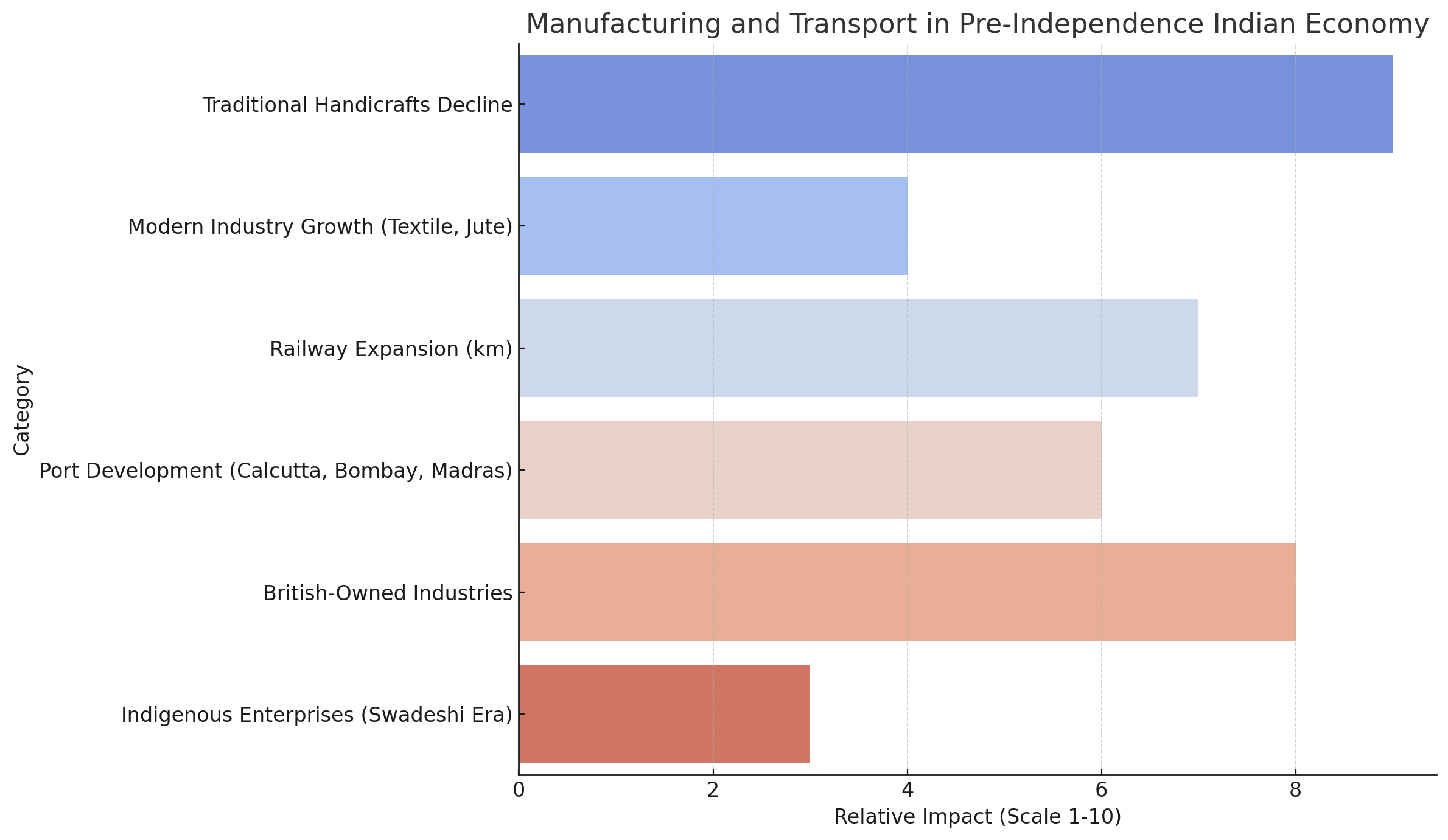
30 Jul Manufacture and Transport in Indian Economy Pre-Independence Era
Manufacture and Transport in Indian Economy (Pre-Independence Era)
Introduction
The economic landscape of pre-independence India was profoundly shaped by British colonial rule. Two critical aspects that underwent significant transformation during this period were manufacturing and transportation. While traditional handicrafts declined under the onslaught of British industrial goods, selective development of transport infrastructure like railways was carried out to facilitate resource extraction and imperial control. This article explores the dynamics of these sectors and their lasting implications on India’s economic trajectory.
Colonial Manufacturing: From Flourish to Decline
1. Deindustrialization of Traditional Sectors
Prior to British rule, India was a major exporter of textiles, metalworks, and handicrafts. Cities like Dhaka, Murshidabad, and Surat were global manufacturing hubs. However, colonial policies facilitated the destruction of these industries:
- Tariff barriers on Indian exports and free entry to British goods
- Deliberate neglect of artisan support and credit
- Disruption due to railways and British distribution networks
This phase is often described as the “deindustrialization” of India.
2. Rise of Modern Manufacturing (Late 19th Century Onward)
The modern industrial sector slowly emerged but was dominated by British capital:
- First cotton mills in Bombay (1854) and jute mills in Bengal (1855)
- Dominance of European capital in mining, plantations, and textiles
- Limited Indian enterprise during Swadeshi movement (1905–1911)
The sector faced challenges like lack of protection, capital scarcity, and British monopolization.
Infographic: Impact Summary

Transport Sector under British India
1. Railways: Colonial Lifeline
- Introduced in 1853, grew to 66,000+ km by 1947
- Served to transport raw materials to ports and British imports to interiors
- Financed via guaranteed return system favoring British investors
While railways connected regions, they were not designed for integrated national development.
2. Road and Canal Development
- Roads remained underdeveloped except for military use
- Canals built mainly for irrigation and some transport (e.g., Upper Ganga Canal)
- Negligible rural connectivity
3. Ports and Shipping
- Major ports: Calcutta, Bombay, Madras developed as export-import nodes
- Indian shipping industry suppressed in favor of British firms
Colonial Strategy Behind Transport Development
- Facilitate export of raw materials (cotton, jute, indigo, opium)
- Enable import of British manufactured goods
- Ensure military mobility to suppress revolts
- Maximize revenue collection and surveillance
The overarching aim was to make the Indian economy subservient to British industrial needs.
Mind Map: Colonial Manufacturing and Transport
Manufacture and Transport in Indian Economy Pre-Independence Era
Impact on Indian Economy
1. Economic Drain
Profits from industries, railways, and plantations were repatriated to Britain. Indian resources were used to build infrastructure that served the colonial economy.
2. Regional Disparities
Industrial activity and infrastructure were concentrated in port cities (Bombay, Calcutta), leaving vast rural hinterlands underdeveloped.
3. Industrial Dualism
Handicrafts declined, while modern factories remained limited. A small, modern sector existed alongside a large, backward traditional sector.
Nationalist Critique and Responses
- Swadeshi Movement advocated indigenous industries
- Nationalist leaders like Dadabhai Naoroji, Gokhale, and R. C. Dutt criticized industrial neglect
- Calls for tariff protection, state intervention, and revival of indigenous industries
- Formation of Indian-owned firms like Tata Iron and Steel (1907)
Legacy of Colonial Industrial and Transport Policy
Colonial policies laid the foundation for regional imbalances, underdevelopment of Indian industry, and a transport system geared toward external trade rather than internal cohesion. Post-independence planning focused on:
- Heavy industrialization through Five-Year Plans
- Expansion of rail and road for national integration
- Protection for domestic industries
Books and Reports
- Poverty and Un-British Rule in India – Dadabhai Naoroji
- The Economic History of India – R. C. Dutt
- Indian Railways and the British Raj – Ian J. Kerr
- Royal Commission on Indian Expenditure (1896)
Previous Year Questions (PYQs)
- Discuss the role of railways in shaping the colonial Indian economy. (UPSC CSE 2016)
- Examine the decline of Indian handicrafts and the rise of modern industry under British rule. (UPSC CSE 2014)
- How did British transport policy affect India’s industrialization? (UPSC CSE 2021)
Probable Questions for Upcoming Exams
- Evaluate the British policy on manufacturing and its impact on the Indian industrial structure.
- Was the development of railways in India a tool of economic development or colonial exploitation?
- Discuss the linkage between British industrial needs and Indian transport policy during colonial rule.
- Compare and contrast indigenous manufacturing before and after colonial rule in India.




No Comments